
The birds-of-paradise are members of the family Paradisaeidae of the order Passeriformes. The majority of species are found in eastern Indonesia, Papua New Guinea, and eastern Australia. The family has 45 species in 17 genera. The members of this family are perhaps best known for the plumage of the males of the species, the majority of which are sexually dimorphic. The males of these species tend to have very long, elaborate feathers extending from the beak, wings, tail, or head. For the most part, they are confined to dense rainforest habitats. The diet of all species is dominated by fruit and to a lesser extent arthropods. The birds-of-paradise have a variety of breeding systems, ranging from monogamy to lek-type polygamy.
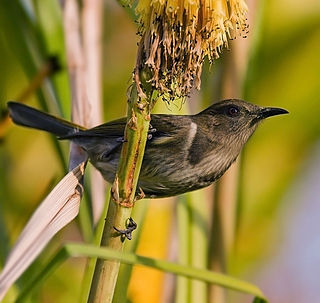
The honeyeaters are a large and diverse family, Meliphagidae, of small to medium-sized birds. The family includes the Australian chats, myzomelas, friarbirds, wattlebirds, miners and melidectes. They are most common in Australia and New Guinea, and found also in New Zealand, the Pacific islands as far east as Samoa and Tonga, and the islands to the north and west of New Guinea known as Wallacea. Bali, on the other side of the Wallace Line, has a single species.

Wilson's bird-of-paradise is a species of passerine bird of the family Paradisaeidae.

The magnificent bird-of-paradise is a species of bird-of-paradise. The magnificent bird-of-paradise is evaluated as Least Concern on the IUCN Red List of Threatened Species. They are listed in Appendix II of CITES.

The greater bird-of-paradise is a bird-of-paradise in the genus Paradisaea.
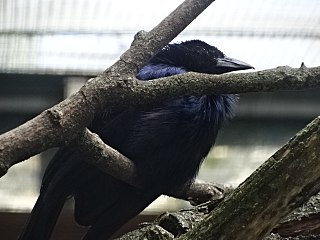
The trumpet manucode is a species of bird in the family Paradisaeidae.
The Jobi manucode is a species of crow-like bird-of-paradise.

The curl-crested manucode is a species of bird-of-paradise.

The glossy-mantled manucode is a species of bird-of-paradise.

The crinkle-collared manucode is a species of bird-of-paradise.
Clifford Brodie Frith is an Australian ornithologist and wildlife photographer. He and his wife Dawn Whyatt Frith have studied and published on Australian birds for many years, and publish books as Frith & Frith.
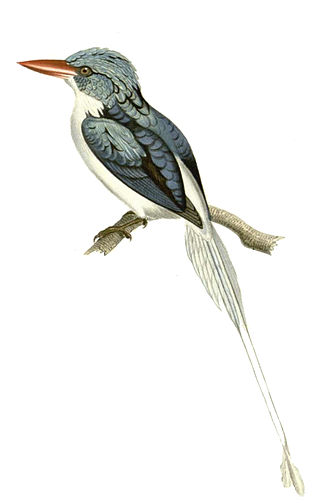
The Biak paradise kingfisher is a tree kingfisher that is endemic to the Indonesian island of Biak which is one of a small group of islands located in Cenderawasih Bay near the northern coast of Papua. This bird has a turquoise-blue back with a white belly and tail streamers and a reddish beak. Its natural habitat is forests and the IUCN has assessed its conservation status as being "near-threatened".

The Trobriand Islands rain forests are a tropical moist broadleaf forest ecoregion of southeastern Papua New Guinea.
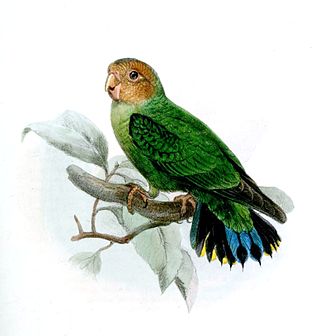
The buff-faced pygmy parrot is a very small green parrot found in subtropical or tropical moist lowland forest in New Britain and New Guinea.
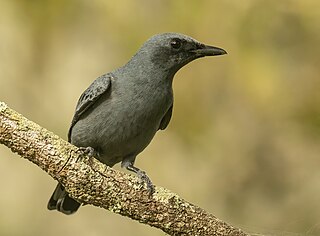
The Sahul cicadabird, previously known as the common cicadabird or slender-billed cicadabird, is a species of passerine bird in the family Campephagidae. It is found in Australia, New Guinea and the Bismarck Archipelago. Its natural habitats are temperate forest and subtropical or tropical moist lowland forest. The species is placed in the reinstated genus Edolisoma by most authors. The common cicadabird was described as a "great speciator" by Mayr & Diamond (2001); and Pedersen et al. (2018) described how this species rapidly colonized and diversified across the Indo-Pacific island region and Australia in the Pleistocene.

The Malagasy paradise flycatcher is a species of bird in the family Monarchidae. It is found in Comoros, Madagascar, and Mayotte. Its natural habitats are subtropical or tropical dry forest and subtropical or tropical moist lowland forest.

The King of Holland's bird of paradise, also known as King William III's bird of paradise or the exquisite little king, is a bird in the family Paradisaeidae that is a hybrid between a magnificent bird of paradise and king bird of paradise.
The lyre-tailed king bird-of-paradise, also known as the lyre-tailed king, lonely little king or crimson bird-of-paradise, is a bird in the family Paradisaeidae that is a hybrid between a king bird-of-paradise and magnificent bird-of-paradise.
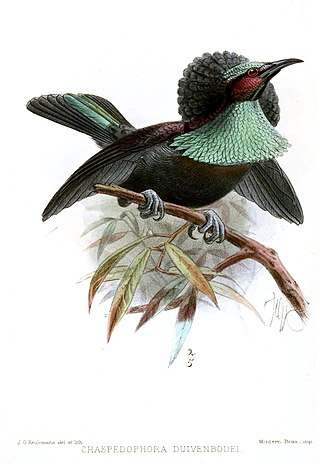
Duivenbode's riflebird is a bird in the family Paradisaeidae that is a presumed intergeneric hybrid between a magnificent riflebird and lesser lophorina. The common name commemorates Maarten Dirk van Renesse van Duivenbode (1804-1878), Dutch trader of naturalia on Ternate.















